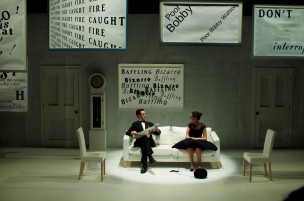
c/o John Carr
Wesleyan’s production of “The Bald Soprano” goes to great lengths to ensure its audience is very clear on what they are getting into before the show even begins. From the entirely white, minimal set, to the signs blaring phrases such as “BIZARRE BAFFLING” and “FIRE CAUGHT FIRE” in overlapping fonts, to the program explaining alienation and Absurdist Theater in detail, director and Professor of Theater Yuri Kordonsky eased his audience into the correct mental state.
And one certainly has to be in the right mental state to enjoy Eugène Ionesco’s “The Bald Soprano.” If the Theater Department wished to find a show as far removed as possible from their last production, “In the Heights,” they found it. In a sense, it’s a play where nothing happens. And yet, at the same time, so very much happens.
The show opens on Mrs. and Mr. Smith (Grace Nix ’15 and Albert Tholen ’15) on a couch in their apartment on the outskirts of London. Between the disjointed clock chimes and discussion of an unknown number people who share the name Bobby Watson, it quickly becomes apparent that there is absolutely no rationality within the world of “The Bald Soprano.” The newspaper that Mr. Smith reads in the beginning is soon torn to pieces and used to beat him senseless. Facts stated moments before are openly contradicted. By the time Natalie May ’18 opens a door and exclaims, “I AM THE MAID!” all pretense of normality has already been eliminated.
The Martins (Edward Archibald ’17 and Sara Fayngolz ’17) arrive as guests for dinner. The couple does not recollect that they are married, or even that they have met before. They are eventually joined by the Fire Captain (Peter McCook ’16), who is a source of infinite absurdity in a play that was extremely absurd to begin. The absurdity steadily increases, as does the cast’s physicality. Characters begin leaping from chairs, have intercourse, and in one case, are potentially murdered behind a closed door. “The Bald Soprano” feels like a 90-minute crescendo, ending with its cast losing all grasp of language and reason and literally destroying the set that has entrapped them as they run screaming and naked into the beyond.
While the physical exertion of the actors is highly impressive, the true delight can be found in the faces. McCook’s expression as he impersonates a chicken impersonating a dog is rivaled only by Tholen’s hiss as he mimics a snake. May’s wide eyes of madness and revelation dole out joy and horror in equal measure. Nix, making her glasses an integral part of her character, never ceases displaying the most hilarious facial expressions by perpetually looking as if she’s close to figuring out something important, but can never quite reach it.
It is quite easy to giggle at nearly every beat in “The Bald Soprano,” but much harder to digest it. The source of the title is as meaningless as much of its dialogue. All we know of the actual soprano is that “she always does her hair the same way,” as Mrs. Smith explains. The show is surely an exercise in absurdity, but it is also a display of characters who find it impossible to connect with each other in any real way. The one time two characters become intimate and seem to be on the same page, they are violently separated by the rest of the cast. Connections of all kinds fail and memory, humor, and time only make the problem worse. Language, more than anything else, impedes everything. Two characters are rarely able to talk about the same thing since they are in their own fluid worlds. “Naughty naughty!” Mr. Smith snaps at his wife for interrupting a tale, as he further interrupts the tale in the process. The script eventually decays to complete gibberish.
The show’s soundscape is just as vibrant of a character as any of the cast members. The grandfather clock serves as an ominous force as it chimes whenever it pleases. Whenever a door is opened or closed (and this happens quite often), the slow creak is used to great comedic effect. With the stark white furniture, walls, and floor, everything is alienating. The whiteness does change. As furniture and actors are tossed about, streak marks fill the floor. The Fire Captain scribbles stick figures over the paper walls as he tells an indecipherable story to a captivated audience. But these changes do not feel inviting to a cold world; they merely add to the chaos.
“The Bald Soprano”—both the show and the Theater Department’s particular production—establishes itself by making its own rules. The play, figuratively and in time quite literally, destroys itself. And it does so in a way that not only is successful but also easily makes it one of the most memorable Wesleyan productions this year. Each member of the cast is at hir finest despite the fact that the characters are hardly even people. One of the highlights involves the Maid, quite seriously, proclaiming that she is Sherlock Holmes.
Where the script’s ending calls for a return to the opening scene but with the Martins in place of the Smiths, Kordonsky instead has the actors rip off their clothes and destroy everything in sight. The Fire Captain hurls an axe through the sign above him, and the walls give way to the empty CFA behind the set. The choice removes the cyclical statement of the ending, but also delivers the biggest gut punch and awe-inspiring climax imaginable. In a show that is nothing but absurdity, the only way to end it is an all-out assault on reason. And there, its characters are finally and truly free.
Comments are closed